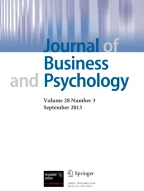Abstract
When utilizing traditional recruitment media, organizations are typically limited to providing job seekers with information solely on their vacant positions. Organizational recruitment websites, on the other hand, allow organizations to provide prospective applicants with both job descriptions and other information about the organization. However, little research exists regarding the impressions that viewers gain from organizational recruitment websites. The present study identified aspects of recruitment websites that may give rise to job seekers’ perceptions of organizational culture. Results indicated that both website design features and information about organizational values, policies, awards, and goals affected viewers’ perceptions of organizational culture.
Similar content being viewed by others
References
Braddy P. W., Thompson L. F., Wuensch K. L., Grossnickle W. F., 2003 Internet recruiting: The effects of web page design features Social Sciences Computer Review, 21(3):374–385
Caldwell D., O’Reilly C., (1990). Measuring person–job fit using a profile comparison process Journal of Applied Psychology 75:648–657
Cappelli P., (2001). Making the most of on-line recruiting Harvard Business Review 79:139–146
Chapman D. S., Webster J., (2003). The use of technologies in the recruiting, screening, and selection processes for job candidates. International Journal of Selection and Assessment, 11:113–120
Chatman J. A., (1989). Improving interactional organizational research: A model of person–organization fit Academy of Management Review 14(3):333–349
Chatman J. A., (1991). Matching people and organizations: Selection and socialization in public accounting firms Administrative Science Quarterly 36(3):459–484
Cober R. T., Brown D. J., Blumental A. J., Doverspike D., Levy P., (2000). The quest for the qualified job surfer: It’s time the public sector catches the wave Public Personnel Management 29(4):479–494
Crispin, G., & Mehler, M. (1997). Recruiting rockets through cyberspace. HR Magazine, 72–77
Elliot R. H., Tevavichulada S., (1999 Computer literacy and human resource management: A public/private sector comparison Public Personnel Management 28:259–274
Fister S., 1999 Online recruiting; good, fast and cheap? Training 36(5):26–28
Gatewood R., Gowan M., Lautenschlager G., (1993). Corporate image, recruitment image, and initial job choice decisions Academy of Management Journal 38:414–427
Glaser B. G., 1992 Emergence vs forcing: Basics of grounded theory analysis Mill Valley, CA Sociology Press
Glaser B. G., Strauss A. L., (1967). The discovery of grounded theory: Strategies for qualitative research. New York: Aldine
Goltz S. M., Giannantonio C. M., 1995 Recruiter friendliness and attraction to the job: The mediating role of inferences about the organization Journal of Vocational Behavior 46(1):109–118
Harrington A., 2002 Can anyone build a better Monster? Fortune 145:189–192
Highhouse S., Zickar M. J., Thorsteinson T. J., Stierwalt S. L., Slaughter J. E., (1999). Assessing company employment image: An example in the fast food industry Personnel Psychology 52:151–172
Judge T. A., Cable D. M., (1997). Applicant personality, organizational culture, and organizational attraction Personnel Psychology 50:359–392
Kay A. S., (2000). Recruiters embrace the Internet Information Week 778:72–80
Kristof A. L., (1996). Person–organization fit: An integrative review of its conceptualizations, measurement, and implications Personnel Psychology 49:1–50
Locke, K. (2002). The grounded theory approach to qualitative research. In N. Schmitt & F. Drasgow (Eds.), Measuring and analyzing behavior in organizations: Advances in measurement and data analysis (pp. 17–43). San Francisco, CA: Jossey Bass
Marcus A., (2001). Is island too small for HR and headhunters? Electronic Engineering Times 1152:129–133
O’Reilly C. A., Chatman J., Caldwell D. F., (1991). People and organizational culture: A profile comparison approach to assessing person–organization fit Academy of Management Review 13:546–558
Recruiting (1999, December). PC Computing, 12(12): 2–7
Rynes S. L., Bretz R. D. J., Gerhart B., (1991). The importance of recruitment in job choice: A different way of looking Personnel Psychology 44:487–521
Rynes S. L., Miller H. E., (1983). Recruiter and job influences on candidates for employment Journal of Applied Psychology 68:147–154
Saks A., Ashforth M., Blake E. (1997) A longitudinal investigation of the relationships between job information sources, applicant perceptions of fit, and work outcomes Personnel Psychology 50 395–423
Schneider B., (1987). The people make the place Personnel Psychology, 40:437–454
Spence M., (1973). Job market signaling Quarterly Journal of Economics 87 355–374
Spence M., (1974). Market-signaling. Cambridge MA Harvard University Press
Turban D. B., (2001) Organizational attractiveness as an employer on college campuses: An examination of the applicant population Journal of Vocational Behavior 58 2: 293–312
Turban D. B., Forret M. L., Hendrickson C. L., (1998). Applicant attraction to firms: Influences of organization reputation, job and organizational attributes, and recruiter behaviors Journal of Vocational Behavior 52 1 24–44
Web Recruiting Advantages: Trends impacting web recruiting (2001). Retrieved September 2001, from http://www.hrsmart.com/recadv.html#Anchor-Trends-5185
Zusman R. R., Landis R. S., 2002 Applicant preferences for web-based versus traditional job postings Computers in Human Behavior 18:285–296
Author information
Authors and Affiliations
Corresponding author
Additional information
Phillip W. Braddy and Christina M. Kroustalis are doctoral students in the Industrial/Organizational Psychology program at North Carolina State University. Adam W. Meade is an Assistant Professor in the Industrial/Organizational Psychology program at North Carolina State University. Thanks to Joshua Storie, Jennifer Stearns, and Tonya Elliott for their assistance in data collection and recording.
Rights and permissions
About this article
Cite this article
Braddy, P.W., Meade, A.W. & Kroustalis, C.M. Organizational recruitment website effects on viewers’ perceptions of organizational culture. J Bus Psychol 20, 525–543 (2006). https://doi.org/10.1007/s10869-005-9003-4
Published:
Issue Date:
DOI: https://doi.org/10.1007/s10869-005-9003-4
